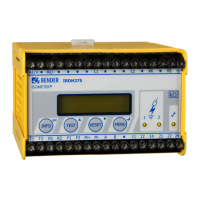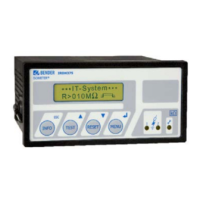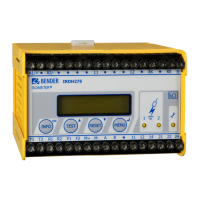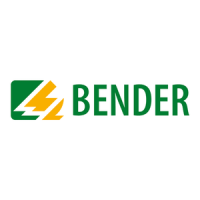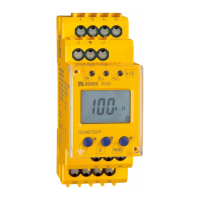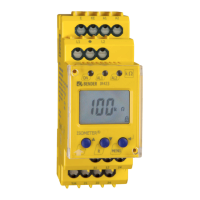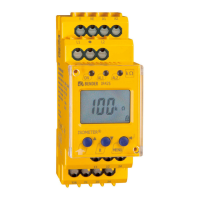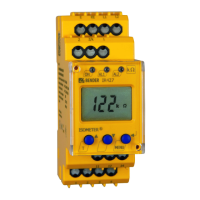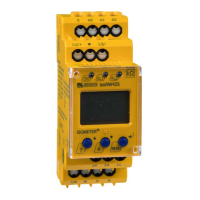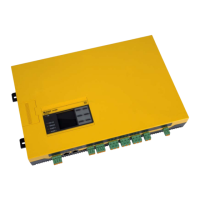Do you have a question about the Bender ISOMETER IRDH575 and is the answer not in the manual?
Explains manual usage and symbols, providing guidance.
Provides contact details for technical assistance, service, and repair.
Details on-site service, installation, and analysis support.
Information on training, delivery conditions, and proper device disposal.
Guidelines for handling, storage, and warranty/liability terms.
General safety guidelines and references to other documentation.
Safety rules for working on electrical installations.
Specific safety precautions related to the ISOMETER® device.
Specifies the intended applications and improper uses of the device.
Lists general features and specifications of the ISOMETER®.
Details the primary operational functions of the ISOMETER®.
Outlines the key functions of the EDS system.
Provides a physical and functional overview of the IRDH575.
Explains operational principles and measurement processes.
Describes the 0-20mA current output functionality.
Details the function and purpose of the real-time clock.
Explains the selective insulation fault location feature.
Discusses operation in interconnected IT systems.
Explains the F1/F2 input for system connection/disconnection.
Details the ISOnet function for networked device control.
Describes the device's comprehensive self-test functions.
Guidelines for connecting external TEST and RESET buttons.
Explains the symbols and terminals used in the wiring diagram.
First part of the commissioning flow for ISOMETER® functions.
First part of the commissioning flow for EDS functions.
Describes the device's controls, display, and indicators.
Explains the display during active EDS and fault conditions.
Shows how the display looks in menu mode.
Details the functions assigned to each key on the device.
Overview of the device's menu navigation and structure.
Visual representation of the menu hierarchy and options.
Details how to access and interpret historical event data.
Settings for basic ISOMETER® functions like alarms and output.
Configuration of alarm thresholds for insulation monitoring.
How alarm values trigger the EDS system.
Explains the behavior of alarm relays K1 and K2.
Configuration of fault memory behavior.
Configuration of the analog current output.
Advanced settings for extended device capabilities.
Notes that external coupling devices are not supported.
Setting for system leakage capacitance to optimize measurements.
Option to switch between AMP and DC measuring principles.
Configures the interval for automatic self-tests.
Setting the device's internal clock for time stamping.
Setting the device's internal date for time stamping.
Defines the specific time for automatic self-tests.
Configuration of parameters for insulation fault location.
Defines start/stop conditions and meanings for EDS systems.
Selection of the monitored system type (DC, AC, 3AC).
Setting the maximum test current for fault location.
Configuration of the K3 relay for error signaling.
Settings for EDS460/490 devices.
General parameters affecting device behavior and display.
Option to switch fault memory on or off for EDS devices.
Specifies how fault location is initiated (IRDH575 or auto).
Parameters for selecting the appropriate device address and channel.
Settings for EDS470 devices.
Displays detected insulation faults and system information.
Checks BMS bus nodes for device address, type, and CT connection.
Resets stored fault messages for connected EDS devices.
Operating principle of alarm relays for EDS47.
Setting the memory behavior for EDS47 devices.
Configuration of CT type and connection monitoring for EDS47.
Setting for automatic elongation of measuring time due to disturbances.
Configuration of the BMS interface and bus address.
Setting the BMS bus address for the IRDH575.
Queries measured values and messages from other bus nodes.
Activates the ISOnet function for networked devices.
Activating and setting a password for unauthorized access.
Protects the device against unauthorized settings and modifications.
Allows setting the language for fault messages.
Selection between German and English for fault messages.
Access for service personnel, protected by password.
Remote configuration and monitoring capabilities.
Details the RS-485 interface and BMS protocol for communication.
Explains the daisy-chain topology for RS-485 networks.
Examples of correct RS-485 network arrangements.
Examples of incorrect RS-485 network arrangements.
Cable types and connection details for RS-485 wiring.
Details the BMS protocol for device communication.
Role and function of the BMS Master device.
Role and function of BMS-Slave devices in the network.
How BMS functions operate when the device is in standby mode.
Illustrates combining IRDH575 with EDS46 devices for fault location.
Step-by-step guide for commissioning an RS-485 BMS network.
Table detailing device addresses and their meanings on the BMS bus.
Technical data presented in a tabular format for easy reference.
Lists relevant industry standards and certifications.
Graphical representations of device performance under various conditions.
Response times vs. system leakage capacitance for ISOMETER®.
Allowable response values for EDS46/EDS49 insulation fault locators.
Allowable response values for the EDS470 insulation fault location system.
Information on ordering different device versions and accessories.
Details the standard versions of the IRDH575 device.
Options for protecting the device from dust and moisture.
Accessories for mounting the device on a DIN rail.
Information on compatible measuring instruments.
Explains manual usage and symbols, providing guidance.
Provides contact details for technical assistance, service, and repair.
Details on-site service, installation, and analysis support.
Information on training, delivery conditions, and proper device disposal.
Guidelines for handling, storage, and warranty/liability terms.
General safety guidelines and references to other documentation.
Safety rules for working on electrical installations.
Specific safety precautions related to the ISOMETER® device.
Specifies the intended applications and improper uses of the device.
Lists general features and specifications of the ISOMETER®.
Details the primary operational functions of the ISOMETER®.
Outlines the key functions of the EDS system.
Provides a physical and functional overview of the IRDH575.
Explains operational principles and measurement processes.
Describes the 0-20mA current output functionality.
Details the function and purpose of the real-time clock.
Explains the selective insulation fault location feature.
Discusses operation in interconnected IT systems.
Explains the F1/F2 input for system connection/disconnection.
Details the ISOnet function for networked device control.
Describes the device's comprehensive self-test functions.
Guidelines for connecting external TEST and RESET buttons.
Explains the symbols and terminals used in the wiring diagram.
First part of the commissioning flow for ISOMETER® functions.
First part of the commissioning flow for EDS functions.
Describes the device's controls, display, and indicators.
Explains the display during active EDS and fault conditions.
Shows how the display looks in menu mode.
Details the functions assigned to each key on the device.
Overview of the device's menu navigation and structure.
Visual representation of the menu hierarchy and options.
Details how to access and interpret historical event data.
Settings for basic ISOMETER® functions like alarms and output.
Configuration of alarm thresholds for insulation monitoring.
How alarm values trigger the EDS system.
Explains the behavior of alarm relays K1 and K2.
Configuration of fault memory behavior.
Configuration of the analog current output.
Advanced settings for extended device capabilities.
Notes that external coupling devices are not supported.
Setting for system leakage capacitance to optimize measurements.
Option to switch between AMP and DC measuring principles.
Configures the interval for automatic self-tests.
Setting the device's internal clock for time stamping.
Setting the device's internal date for time stamping.
Defines the specific time for automatic self-tests.
Configuration of parameters for insulation fault location.
Defines start/stop conditions and meanings for EDS systems.
Selection of the monitored system type (DC, AC, 3AC).
Setting the maximum test current for fault location.
Configuration of the K3 relay for error signaling.
Settings for EDS460/490 devices.
General parameters affecting device behavior and display.
Option to switch fault memory on or off for EDS devices.
Specifies how fault location is initiated (IRDH575 or auto).
Parameters for selecting the appropriate device address and channel.
Settings for EDS470 devices.
Displays detected insulation faults and system information.
Checks BMS bus nodes for device address, type, and CT connection.
Resets stored fault messages for connected EDS devices.
Operating principle of alarm relays for EDS47.
Setting the memory behavior for EDS47 devices.
Configuration of CT type and connection monitoring for EDS47.
Setting for automatic elongation of measuring time due to disturbances.
Configuration of the BMS interface and bus address.
Setting the BMS bus address for the IRDH575.
Queries measured values and messages from other bus nodes.
Activates the ISOnet function for networked devices.
Activating and setting a password for unauthorized access.
Protects the device against unauthorized settings and modifications.
Allows setting the language for fault messages.
Selection between German and English for fault messages.
Access for service personnel, protected by password.
Remote configuration and monitoring capabilities.
Details the RS-485 interface and BMS protocol for communication.
Explains the daisy-chain topology for RS-485 networks.
Examples of correct RS-485 network arrangements.
Examples of incorrect RS-485 network arrangements.
Cable types and connection details for RS-485 wiring.
Details the BMS protocol for device communication.
Role and function of the BMS Master device.
Role and function of BMS-Slave devices in the network.
How BMS functions operate when the device is in standby mode.
Illustrates combining IRDH575 with EDS46 devices for fault location.
Step-by-step guide for commissioning an RS-485 BMS network.
Table detailing device addresses and their meanings on the BMS bus.
Technical data presented in a tabular format for easy reference.
Lists relevant industry standards and certifications.
Graphical representations of device performance under various conditions.
Response times vs. system leakage capacitance for ISOMETER®.
Allowable response values for EDS46/EDS49 insulation fault locators.
Allowable response values for the EDS470 insulation fault location system.
Information on ordering different device versions and accessories.
Details the standard versions of the IRDH575 device.
Options for protecting the device from dust and moisture.
Accessories for mounting the device on a DIN rail.
Information on compatible measuring instruments.
| Display | LCD |
|---|---|
| Automatic adaptation to system leakage capacitance | Yes |
| Separate test current circuit | Yes |
| Two separately adjustable response values | Yes |
| Two changeover contacts | Yes |
| Connection monitoring (L1, L2, PE) | Yes |
| Self-monitoring with automatic function test | Yes |
| Device version with Modbus RTU interface available | Yes |
| NFC interface | Yes |
| Push-wire terminals | Yes |
| Model | IRDH575 |
| Measuring Range | 0-10 MΩ |
| Output | 2 changeover contacts |
| Operating temperature | -20…+60 °C |
| Storage temperature | -40…+70 °C |
| Protection class | IP20 |
